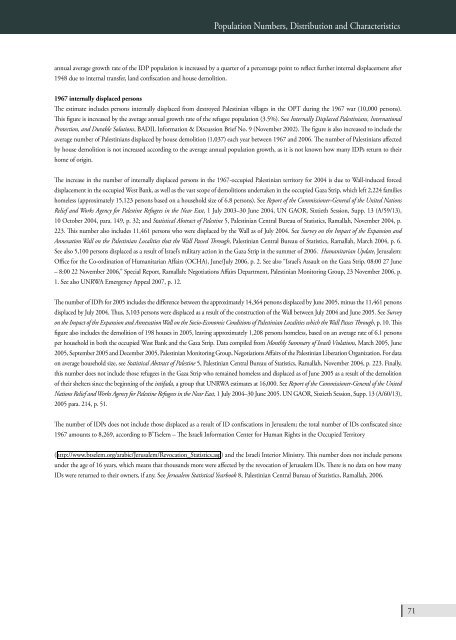BADIL Resource Center for Palestinian Residency and Refugee
BADIL Resource Center for Palestinian Residency and Refugee
BADIL Resource Center for Palestinian Residency and Refugee
Create successful ePaper yourself
Turn your PDF publications into a flip-book with our unique Google optimized e-Paper software.
Population Numbers, Distribution <strong>and</strong> Characteristics<br />
annual average growth rate of the IDP population is increased by a quarter of a percentage point to reflect further internal displacement after<br />
1948 due to internal transfer, l<strong>and</strong> confiscation <strong>and</strong> house demolition.<br />
1967 internally displaced persons<br />
The estimate includes persons internally displaced from destroyed <strong>Palestinian</strong> villages in the OPT during the 1967 war (10,000 persons).<br />
This figure is increased by the average annual growth rate of the refugee population (3.5%). See Internally Displaced <strong>Palestinian</strong>s, International<br />
Protection, <strong>and</strong> Durable Solutions, <strong>BADIL</strong> In<strong>for</strong>mation & Discussion Brief No. 9 (November 2002). The figure is also increased to include the<br />
average number of <strong>Palestinian</strong>s displaced by house demolition (1,037) each year between 1967 <strong>and</strong> 2006. The number of <strong>Palestinian</strong>s affected<br />
by house demolition is not increased according to the average annual population growth, as it is not known how many IDPs return to their<br />
home of origin.<br />
The increase in the number of internally displaced persons in the 1967-occupied <strong>Palestinian</strong> territory <strong>for</strong> 2004 is due to Wall-induced <strong>for</strong>ced<br />
displacement in the occupied West Bank, as well as the vast scope of demolitions undertaken in the occupied Gaza Strip, which left 2,224 families<br />
homeless (approximately 15,123 persons based on a household size of 6.8 persons). See Report of the Commissioner-General of the United Nations<br />
Relief <strong>and</strong> Works Agency <strong>for</strong> Palestine <strong>Refugee</strong>s in the Near East, 1 July 2003–30 June 2004, UN GAOR, Sixtieth Session, Supp. 13 (A/59/13),<br />
10 October 2004, para. 149, p. 32; <strong>and</strong> Statistical Abstract of Palestine 5, <strong>Palestinian</strong> Central Bureau of Statistics, Ramallah, November 2004, p.<br />
223. This number also includes 11,461 persons who were displaced by the Wall as of July 2004. See Survey on the Impact of the Expansion <strong>and</strong><br />
Annexation Wall on the <strong>Palestinian</strong> Localities that the Wall Passed Through, <strong>Palestinian</strong> Central Bureau of Statistics, Ramallah, March 2004, p. 6.<br />
See also 5,100 persons displaced as a result of Israel’s military action in the Gaza Strip in the summer of 2006. Humanitarian Update, Jerusalem:<br />
Office <strong>for</strong> the Co-ordination of Humanitarian Affairs (OCHA), June/July 2006, p. 2. See also “Israel’s Assault on the Gaza Strip, 08:00 27 June<br />
– 8:00 22 November 2006,” Special Report, Ramallah: Negotiations Affairs Department, <strong>Palestinian</strong> Monitoring Group, 23 November 2006, p.<br />
1. See also UNRWA Emergency Appeal 2007, p. 12.<br />
The number of IDPs <strong>for</strong> 2005 includes the difference between the approximately 14,364 persons displaced by June 2005, minus the 11,461 persons<br />
displaced by July 2004. Thus, 3,103 persons were displaced as a result of the construction of the Wall between July 2004 <strong>and</strong> June 2005. See Survey<br />
on the Impact of the Expansion <strong>and</strong> Annexation Wall on the Socio-Economic Conditions of <strong>Palestinian</strong> Localities which the Wall Passes Through, p. 10. This<br />
figure also includes the demolition of 198 houses in 2005, leaving approximately 1,208 persons homeless, based on an average rate of 6.1 persons<br />
per household in both the occupied West Bank <strong>and</strong> the Gaza Strip. Data compiled from Monthly Summary of Israeli Violations, March 2005, June<br />
2005, September 2005 <strong>and</strong> December 2005, <strong>Palestinian</strong> Monitoring Group, Negotiations Affairs of the <strong>Palestinian</strong> Liberation Organization. For data<br />
on average household size, see Statistical Abstract of Palestine 5, <strong>Palestinian</strong> Central Bureau of Statistics, Ramallah, November 2004, p. 223. Finally,<br />
this number does not include those refugees in the Gaza Strip who remained homeless <strong>and</strong> displaced as of June 2005 as a result of the demolition<br />
of their shelters since the beginning of the intifada, a group that UNRWA estimates at 16,000. See Report of the Commissioner-General of the United<br />
Nations Relief <strong>and</strong> Works Agency <strong>for</strong> Palestine <strong>Refugee</strong>s in the Near East, 1 July 2004–30 June 2005. UN GAOR, Sixtieth Session, Supp. 13 (A/60/13),<br />
2005 para. 214, p. 51.<br />
The number of IDPs does not include those displaced as a result of ID confiscations in Jerusalem; the total number of IDs confiscated since<br />
1967 amounts to 8,269, according to B’Tselem – The Israeli In<strong>for</strong>mation <strong>Center</strong> <strong>for</strong> Human Rights in the Occupied Territory<br />
(http://www.btselem.org/arabic/Jerusalem/Revocation_Statistics.asp) <strong>and</strong> the Israeli Interior Ministry. This number does not include persons<br />
under the age of 16 years, which means that thous<strong>and</strong>s more were affected by the revocation of Jerusalem IDs. There is no data on how many<br />
IDs were returned to their owners, if any. See Jerusalem Statistical Yearbook 8, <strong>Palestinian</strong> Central Bureau of Statistics, Ramallah, 2006.<br />
71

















